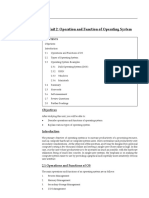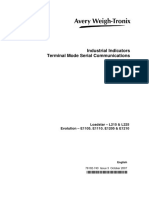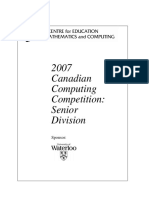Operating System Syllabus Organization
Uploaded by
ayushkumar32388Operating System Syllabus Organization
Uploaded by
ayushkumar32388Operating System Syllabus Organization
UNIT I: Introduction to Operating Systems
1. Introduction to Operating Systems
o Definition and Objectives of an Operating System
What is an operating system?
Primary functions: abstraction, resource management, interaction with hardware
o Functions of an Operating System
Process management, memory management, file systems, I/O management, security, and
protection
o Components of an Operating System
Kernel, Shell, System Calls, User Interface, Device Drivers
2. Evolution of Operating Systems
o Historical context: From early mainframes to modern systems
o Key milestones in OS evolution: Batch processing, time-sharing, multi-programming, distributed
systems, cloud computing
3. Types of Operating Systems
o Batch Systems: Characteristics, jobs submitted in batches
o Interactive Systems: User interaction through commands, immediate responses
o Time-Sharing Systems: Multi-user systems with time-slicing for fair resource allocation
o Embedded Operating Systems: Specialized for specific hardware with real-time constraints
o Real-Time Operating Systems: Hard vs. soft real-time systems, timing constraints
4. Protection in Operating Systems
o Importance of security and protection in multi-user environments
o Mechanisms: User authentication, access control, auditing
UNIT II: Process Management [CO2] (8 Hrs)
1. Process Management Concepts
o Definition of a Process
What is a process?
Difference between a program and a process
o Process States: New, ready, running, waiting, terminated
o Process State Transitions: How processes move between states
2. Process Control Block (PCB)
o Structure and role of the PCB in process management
3. Operations on Processes
o Suspend and Resume: Temporarily halting and restarting processes
o Interrupt Processing: How the OS handles interrupts and switches context
4. Mutual Exclusion and Concurrency
o Critical Section Problem
Shared resources and process synchronization
Methods for achieving mutual exclusion
o Producer/Consumer Problem: Example of synchronization
o Semaphores: Definition, usage for process synchronization
5. Inter-process Communication (IPC)
o Message Passing: Sending and receiving messages between processes
o Shared Memory: Communicating through a common memory space
6. CPU Scheduling
o Scheduling Concepts: Objectives of CPU scheduling, scheduling queue
o Scheduling Algorithms
FCFS (First-Come, First-Served)
SJF (Shortest Job First)
Round Robin, Priority Scheduling, Multilevel Queue
o Algorithm Evaluation: Metrics like waiting time, turnaround time, throughput
7. Deadlocks
o System Model: Resource allocation graph
o Deadlock Characterization: Necessary conditions for deadlock
o Deadlock Handling
Prevention: Ensure one or more deadlock conditions are violated
Avoidance: Resource allocation policies like the Banker's algorithm
Detection: Identifying deadlock after it occurs
Recovery: Killing processes or rolling back resources
o Combined Approach: Using a combination of techniques for better results
UNIT III: Memory Management
1. Multiprogramming Techniques
o Fixed Partitioning: Dividing memory into fixed-size partitions
o Variable Partitioning: Allocating partitions dynamically
2. Memory Management Techniques
o Paging: Concept of pages and page tables
o Segmentation: Dividing memory into segments based on logical divisions (e.g., code, data)
o Paged Segmentation: Combining paging and segmentation to avoid fragmentation
3. Virtual Memory Concepts
o Demand Paging: Loading pages into memory only when needed
o Page Replacement Algorithms
FIFO (First-In-First-Out)
LRU (Least Recently Used)
Optimal Algorithm
o Thrashing: When too many pages are being swapped in and out, degrading performance
4. Memory Allocation Techniques
o Frame Allocation: How memory is allocated to processes
o Cache Memory Organization: Techniques for improving memory access speeds
UNIT IV: I/O Management
1. I/O Devices and Organization
o I/O Function: Interfacing with hardware, handling input and output
o I/O Buffering: Using buffers to smooth out discrepancies between I/O speeds and CPU speeds
o Direct Memory Access (DMA): Enabling devices to directly transfer data to/from memory without
involving the CPU
2. File System Management
o File Concepts: File attributes, file types
o File Organization and Access Mechanisms
Sequential, direct, and indexed access
o File Directories and Sharing: Structuring files and sharing access
o File Implementation Issues: File allocation, management of space on disk
3. Disk Scheduling Algorithms
o FCFS (First-Come, First-Served)
o SSTF (Shortest Seek Time First)
o SCAN and C-SCAN (Elevator algorithms)
UNIT V: Case Study: The Unix/Linux System
1. Unix/Linux System Architecture and Features
o Overview of Unix/Linux architecture
o Multi-user, multitasking design
2. Unix File System Layout
o Boot Block: First block, containing startup information
o Super Block: Metadata for file system (size, free blocks, etc.)
o Inode Block: Stores metadata about files
o Data Block: Stores actual file data
o Inode Concept: Structure and function of inodes in Unix/Linux
3. Unix/Linux Commands and Utilities
o Basic commands: PATH, who, date, pwd, mkdir, cd, ls, cp, mv, rm, etc.
o File Handling: cat, more, cp, mv, rm, chmod
o Pipes and Redirection: |, >, >>, <, and file manipulation
o Filters: grep, uniq, cmp, tr, etc.
o Writing and Executing Shell Scripts: Basics of creating and running simple shell scripts
Study Plan Tips:
Start with Definitions and Concepts: For each unit, begin with understanding the fundamental definitions
and core concepts.
Practice with Examples: For topics like CPU scheduling and memory management, work through examples or
problems to get a deeper understanding.
Hands-on Practice: Try using Unix/Linux commands and write simple shell scripts as you go through the last
unit. This will give you practical experience with the OS.
Diagramming: For complex topics like memory management (paging, segmentation) and deadlock handling,
sketch diagrams or flowcharts to visualize the processes.
Let me know if you need further clarification on any topic or specific subtopics, and I’d be happy to help with study
resources or practice problems!
You might also like
- Eprompt Answer Key Book 1 To 5 - Updated - 24-04-2023100% (3)Eprompt Answer Key Book 1 To 5 - Updated - 24-04-202354 pages
- OPERATING SYSTEMS_39455505_2025_01_23_16_05No ratings yetOPERATING SYSTEMS_39455505_2025_01_23_16_0543 pages
- principles-of-operating-system-swe210_1716371553No ratings yetprinciples-of-operating-system-swe210_171637155370 pages
- Cbs1006 Principles-Of-operating-systems Eth 1.0 63 Cbs1006 59 AcpNo ratings yetCbs1006 Principles-Of-operating-systems Eth 1.0 63 Cbs1006 59 Acp3 pages
- HTTP - App - Utu.ac - in - Utuexmanagement - Exammsters - Syllabus - CE2010-Operating System1No ratings yetHTTP - App - Utu.ac - in - Utuexmanagement - Exammsters - Syllabus - CE2010-Operating System14 pages
- Operating systems Assignment - Form 1 - Computer StudiesNo ratings yetOperating systems Assignment - Form 1 - Computer Studies2 pages
- Cse2005 Operating-Systems Eth 1.0 37 Cse2005No ratings yetCse2005 Operating-Systems Eth 1.0 37 Cse20052 pages
- Operating Systems: Concepts to Save Money, Time, and FrustrationFrom EverandOperating Systems: Concepts to Save Money, Time, and FrustrationNo ratings yet
- Important questions of digital electronicsNo ratings yetImportant questions of digital electronics33 pages
- HLD6000 Operating Instructions Kinb43en1 04 (1506)No ratings yetHLD6000 Operating Instructions Kinb43en1 04 (1506)76 pages
- Pablo Guede - Respirar Futbol - Compressed PDFNo ratings yetPablo Guede - Respirar Futbol - Compressed PDF99 pages
- ATV32 - ATV320 How To Diagnose A SAFF FaultNo ratings yetATV32 - ATV320 How To Diagnose A SAFF Fault19 pages
- Modicon TSX Micro Automation Platform: Presentation, Description, SelectionNo ratings yetModicon TSX Micro Automation Platform: Presentation, Description, Selection14 pages
- RINS1903-1 UK Combined Enforcer Installation Manual (INTERNAL-PRINT)No ratings yetRINS1903-1 UK Combined Enforcer Installation Manual (INTERNAL-PRINT)16 pages
- Problem Solving Techniques AND Computer ProgrammingNo ratings yetProblem Solving Techniques AND Computer Programming34 pages
- Chapter 1 - Introduction To Computer Architecture and OrganizationNo ratings yetChapter 1 - Introduction To Computer Architecture and Organization21 pages
- Practical - 1: Aim: - Introduction To 8085 MicroprocessorNo ratings yetPractical - 1: Aim: - Introduction To 8085 Microprocessor7 pages
- Ekor - Soft: Configuration Software For Protection and Integrated Control UnitsNo ratings yetEkor - Soft: Configuration Software For Protection and Integrated Control Units28 pages
- 2007 Canadian Computing Competition: Senior Division: SponsorNo ratings yet2007 Canadian Computing Competition: Senior Division: Sponsor10 pages
- Eprompt Answer Key Book 1 To 5 - Updated - 24-04-2023Eprompt Answer Key Book 1 To 5 - Updated - 24-04-2023
- Cbs1006 Principles-Of-operating-systems Eth 1.0 63 Cbs1006 59 AcpCbs1006 Principles-Of-operating-systems Eth 1.0 63 Cbs1006 59 Acp
- HTTP - App - Utu.ac - in - Utuexmanagement - Exammsters - Syllabus - CE2010-Operating System1HTTP - App - Utu.ac - in - Utuexmanagement - Exammsters - Syllabus - CE2010-Operating System1
- Operating systems Assignment - Form 1 - Computer StudiesOperating systems Assignment - Form 1 - Computer Studies
- Operating Systems: Concepts to Save Money, Time, and FrustrationFrom EverandOperating Systems: Concepts to Save Money, Time, and Frustration
- HLD6000 Operating Instructions Kinb43en1 04 (1506)HLD6000 Operating Instructions Kinb43en1 04 (1506)
- Modicon TSX Micro Automation Platform: Presentation, Description, SelectionModicon TSX Micro Automation Platform: Presentation, Description, Selection
- RINS1903-1 UK Combined Enforcer Installation Manual (INTERNAL-PRINT)RINS1903-1 UK Combined Enforcer Installation Manual (INTERNAL-PRINT)
- Problem Solving Techniques AND Computer ProgrammingProblem Solving Techniques AND Computer Programming
- Chapter 1 - Introduction To Computer Architecture and OrganizationChapter 1 - Introduction To Computer Architecture and Organization
- Practical - 1: Aim: - Introduction To 8085 MicroprocessorPractical - 1: Aim: - Introduction To 8085 Microprocessor
- Ekor - Soft: Configuration Software For Protection and Integrated Control UnitsEkor - Soft: Configuration Software For Protection and Integrated Control Units
- 2007 Canadian Computing Competition: Senior Division: Sponsor2007 Canadian Computing Competition: Senior Division: Sponsor





























































































